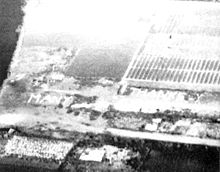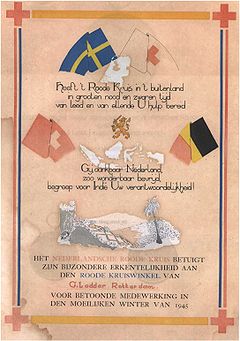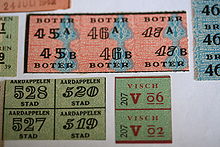- Dutch famine of 1944
-
See also: History of the Netherlands (1939–1945)
The Dutch famine of 1944, known as the Hongerwinter ("Hunger winter") in Dutch, was a famine that took place in the German-occupied part of the Netherlands, especially in the densely populated western provinces above the great rivers, during the winter of 1944-1945, near the end of World War II. A German blockade cut off food and fuel shipments from farm areas. A total of 18,000 Dutch citizens died due to the famine.[1] Many of the 18,000 victims were reported to be elderly men.[2]
Contents
Causes and history
Towards the end of World War II, food supplies became increasingly scarce in the Netherlands. After the landing of the Allied Forces on D-Day, conditions grew increasingly worse in the Nazi-occupied Netherlands. The Allies were able to liberate the southern part of the country, but their liberation efforts came to an abrupt halt when Operation Market Garden, their attempt to gain control of the bridge across the Rhine at Arnhem, failed. The seizure of the approaches to the port of Antwerp (the Battle of the Scheldt) was delayed due to Montgomery's preoccupation with Market Garden.
After the national railways complied with the exiled Dutch government's appeal for a railway strike starting September 1944 to further the Allied liberation efforts, the German administration retaliated by placing an embargo on all food transports to the western Netherlands.
By the time the embargo was partially lifted in early November 1944, allowing restricted food transports over water, the unusually early and harsh winter had already set in. The canals froze over and became impassable for barges.
Food
Food stocks in the cities in the western Netherlands rapidly ran out. The adult rations in cities such as Amsterdam had dropped to below 1000 kilocalories (4,200 kilojoules) a day by the end of November 1944 and to 580 kilocalories in the west by the end of February 1945.[3] Over this winter, later known as the Hongerwinter ("Hunger winter"), a number of factors combined to cause starvation of the Dutch people: the winter itself was unusually harsh and the retreating German army destroyed docks and bridges to flood the country and impede the Allied advance. As the Netherlands became one of the main western battlefields, the widespread dislocation and destruction of the war ruined much of its agricultural land and made the transport of existing food stocks difficult.
The areas affected were home to 4.5 million people. Butter disappeared after October 1944. The supply of vegetable fats dwindled to a minuscule seven-month supply of 1.3 liters per person. At first 100 grams of cheese were allotted every two weeks; the meat coupons became worthless. The bread ration had already dropped from 2,200 to 1,800 and then to 1,400 grams per week. Then it fell to 1,000 grams in October, and by April 1945 to 400 grams a week. Together with one kilogram of potatoes, this then formed the entire weekly ration. The black market increasingly ran out of food as well, and with the gas and electricity and heat turned off, everyone was very cold and very hungry.[4]
In search of food, people would walk for tens of kilometers to trade valuables for food at farms. Tulip bulbs and sugarbeets were commonly consumed. Furniture and houses were dismantled to provide fuel for heating. From September 1944 until early 1945 the deaths of 18,000 Dutch people were attributed to malnutrition as the primary cause and in many more as a contributing factor.[3] The Dutch Famine ended with the liberation of the western Netherlands in May 1945. Shortly before that, some relief had come from the 'Swedish bread', which was actually baked in the Netherlands but made from flour shipped in from Sweden. Shortly after these shipments, the German occupiers allowed coordinated air drops of food by the Royal Air Force over German-occupied Dutch territory in Operation Manna. The two events are often confused, even resulting in the commemoration of bread being dropped from airplanes, something that never happened.
Legacy
This famine was unique as it took place in a modern, developed and literate country, albeit suffering under the privations of occupation and war. The well-documented experience has allowed scientists to measure the effects of famine on human health.
The Dutch Famine Birth Cohort Study, carried out by the departments of Clinical Epidemiology and Biostatistics, Gynecology and Obstetrics and Internal Medicine of the Academic Medical Centre in Amsterdam, in collaboration with the MRC Environmental Epidemiology Unit of the University of Southampton in Britain, found that the children of pregnant women exposed to famine were more susceptible to diabetes, obesity, cardiovascular disease, microalbuminuria and other health problems.[5]
Moreover, the children of the women who were pregnant during the famine were smaller, as expected. However, surprisingly, when these children grew up and had children those children were also smaller than average.[citation needed]
This data suggested that the famine experienced by the mothers caused some kind of epigenetic changes that were passed down to the next generation.
The discovery of the cause of Coeliac disease may also be partly attributed to the Dutch famine. With wheat in very short supply there was an improvement of a children's ward of Coeliac patients. Stories tell of the first precious supplies of bread being given specifically to the (no longer) sick children, prompting an immediate relapse. Thus in the 1940s the Dutch paediatrician Dr. Willem Dicke[6] was able to corroborate his previously researched hypothesis that wheat intake was aggravating Coeliac disease.[7] Later Dicke went on to prove his theory.
Audrey Hepburn spent her childhood in the Netherlands during the famine. She suffered from anemia, respiratory illnesses, and edema as a result. Also, her clinical depression later in life has been attributed to malnutrition.[8]
Subsequent academic research on the children who were affected in the second trimester of their mother's pregnancy, found an increased incidence of schizophrenia in these children.[9] Also increased among them were the rates of schizotypal personality and neurological defects.[10]
See also
- List of famines
- Effect of the Siege of Leningrad on the city
- Historical trauma
- Prenatal nutrition and birth weight
- Överkalix study
- Transgenerational epigenetics
References
- ^ Henri A. van der Zee, The Hunger Winter: Occupied Holland 1944-1945, University of Nebraska Press, 1998. pp.304-305
- ^ Banning (1946) p.99
- ^ a b STEIN, Z. (1975). Famine and human development: the Dutch hunger winter of 1944-1945. New York, Oxford University Press. ISBN 0-195-01811-7
- ^ Banning (1946) p 93
- ^ http://ihome.ust.hk/~lbcaplan/dutchfamine.html Bibliography of Dutch Famine of 1944
- ^ van Berge-Henegouwen G, Mulder C (1993). "Pioneer in the gluten free diet: Willem-Karel Dicke 1905-1962, over 50 years of gluten free diet" (PDF). Gut 34 (11): 1473–5. doi:10.1136/gut.34.11.1473. PMC 1374403. PMID 8244125. http://gut.bmj.com/cgi/reprint/34/11/1473. Full text at PMC: 1374403
- ^ Dicke WK. Coeliakie: een onderzoek naar de nadelige invloed van sommige graansoorten op de lijder aan coeliakie [PhD thesis]. Utrecht, the Netherlands: University of Utrecht, 1950.
- ^ Garner, Lesley. Lesley Garner meets the legendary actress as she prepares for this week's Unicef gala performance, The Sunday Telegraph, May 26, 1991
- ^ Brown AS, Susser ES (November 2008). "Prenatal Nutritional Deficiency and Risk of Adult Schizophrenia". Schizophr Bull 34 (6): 1054–63. doi:10.1093/schbul/sbn096. PMC 2632499. PMID 18682377. http://schizophreniabulletin.oxfordjournals.org/cgi/pmidlookup?view=long&pmid=18682377.
- ^ Walker, Elaine E.; Cicchetti, Dante (2003). Neurodevelopmental mechanisms in psychopathology. Cambridge, UK: Cambridge University Press. ISBN 0-521-00262-1., на стр. 88-93
Bibliography
- Banning, C. "Food Shortage and Public Health, First Half of 1945," Annals of the American Academy of Political and Social Science Vol. 245, The Netherlands during German Occupation (May, 1946), pp. 93–110 in JSTOR
- Collingham, E. M. The Taste of War: World War Two and the Battle for Food (2011)
- Hart, Nicky . "Famine, Maternal Nutrition and Infant Mortality: A Re-Examination of the Dutch Hunger Winter," Population Studies Vol. 47, No. 1 (Mar., 1993), pp. 27–46 in JSTOR
- Hitchcock, William I. The Bitter Road to Freedom: The Human Cost of Allied Victory in World War II Europe (2009) pp 98–129
- Sas, Anthony. "Holland's 'Hunger Winter' of 1944-45," Military Review, Sep 1983, Vol. 63 Issue 9, pp 24–32
- Sellin, Thorsten, ed. "The Netherlands during German Occupation," Annals of the American Academy of Political and Social Science Vol. 245, May, 1946 pp i to 180 in JSTOR
- Stein, Zena, ed. Famine and human development: The Dutch hunger winter of 1944-1945 (1975)
- van der Zee, Henri A. The Hunger Winter: Occupied Holland 1944-1945 (University of Nebraska Press, 1998)
•Warmbrunn, Werner. The Dutch under German Occupation 1940–1945 (Stanford U.P. 1963)
External links
- http://www.dutchfamine.nl The Dutch Famine Birth Cohort Study
- http://stadsarchief.amsterdam.nl/english/amsterdam_treasures/second_world_war/tulip-bulb_puree/index.en.html Recipe for tulip-bulb puree at the Amsterdam City Archives
Multimedia
- CBC Archives - CBC Radio (April 22, 1945) reporting on the famine in Apeldoorn and the inflation of food prices.
- CBC Archives - CBC Radio (April 30, 1945) reporting on the agreement to provide food to the Dutch.
World War II Participants Timeline Aspects GeneralWar crimes- German and Wehrmacht war crimes
- The Holocaust
- Italian war crimes
- Japanese war crimes
- Unit 731
- Allied war crimes
- Soviet war crimes
- United States war crimes
- German military brothels
- Camp brothels
- Rape during the occupation of Japan
- Comfort women
- Rape of Nanking
- Rape during the occupation of Germany
- Nazi crimes against Soviet POWs
- Italian prisoners of war in the Soviet Union
- Japanese prisoners of war in the Soviet Union
- Japanese prisoners of war in World War II
- German prisoners of war in the Soviet Union
- Finnish prisoners of war in the Soviet Union
- Polish prisoners of war in the Soviet Union
- Romanian prisoners of war in the Soviet Union
- German prisoners of war in the United States
Categories:- History of the Netherlands
- Famines
- Military history of the Netherlands during World War II
- 1944 in the Netherlands
- 1945 in the Netherlands
Wikimedia Foundation. 2010.



